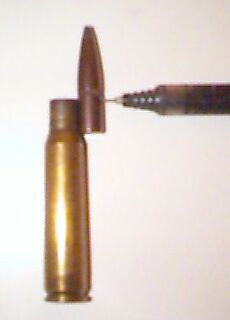by Junior Doughty
|
On the "Instructions" page of the Lee Precision web site, you will find, in downloadable .pdf format, a Volume Measure Density table listing nearly all powders available to reloaders. The table gives the volume in cubic centimeters–cc or cm³–of 1 grain of each powder. You should download that file and keep it on your computer or print it and tape it to the wall beside your loading bench. It's a handy thing to have. I thank Lee for making it so readily available. Here's two reasons it's useful:
From the table we see that a maximum charge of IMR 3031 will fill the 30 Rammerjammer case the most, and a maximum charge of H 4198 will fill it the least—2.4 cm³ versus 1.69 cm³.
Here's how to do that:
Place a bullet of the same caliber as the case beside the case and with its base at the bottom of the case's neck. Then mark the bullet at a point even with the top of the neck. Fill the case with water, then ease the bullet into the neck, stopping at the mark. As it enters the neck, the bullet displaces the water in the neck. Remove the bullet, carefully wipe the outside of the case dry, then weigh it. For me, a 7 x 57 Mauser w/water = 222 gr. So 222 - 167 = 55 grs of water in the case
55 grs of water ÷ 15.4 = 3.57 grams = 3.57 cm³.
So the bottom-of-the-neck case capacity of my So to determine how much of any powder will fill my 7 x 57 case to the bottom of the neck, I then:
Let's look at two powders from Lee Precision's table: IMR 4831 and H 4831:
IMR 4831 VMD value = .0735
H 4831 VMD value = .0725 Here's an extremely important use for VMD data. If you look closely at the neck of the 7 x 57 case in the photo above, you might notice a slight bulge about 1/3 of the way up the neck. I shot that case with a light load in my M 93 Spanish Mauser Boat Rifle, written about here. Light loads of spherical powder in bottleneck cases can create a localized high-pressure phenomenon called "neck ring." Much has been written about neck ring and what causes it in a case not completely filled with relatively slow burning powder. I suspect the primer blast spreads the powder granules apart and simultaneously ignites them all at once instead of in a progressive ignition sequence. Whatever the cause, my light load ringed the neck of my M 93's chamber. I now use a load of 45 grs of H 4831 which has a VMD value of .0725. 45 x .0725 = 3.26 3.26 ÷ 3.57 = .91 = 91% of the bottom-of-the-neck case capacity using H 4831. Almost no air space. Thank you, Lee Precision.
| ||||||||||||||||||||||||||||||||||||||||||||||||||||||||
 In the photo we see a 7 x 57 Mauser case and bullet.
In the photo we see a 7 x 57 Mauser case and bullet.